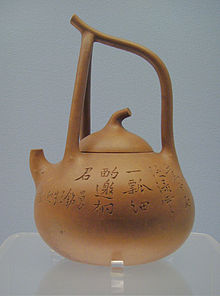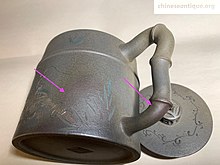Yixing clay teapot
This article needs additional citations for verification. (August 2012) |


Yixing clay teapots (
History
This section needs expansion with: history during the 1000-year period between its origins and the 20th century. You can help by adding to it. (January 2013) |
Archaeological excavations reveal that as early as the Song dynasty (10th century) potters near Yixing were using local "zisha" (紫砂 or 紫泥 ; literally, "purple sand/clay") to make utensils that may have functioned as teapots. According to the Ming dynasty author Zhou Gaoqi, during the reign of the Zhengde Emperor, a monk from Jinsha Temple (Golden Sand Temple) in Yixing handcrafted a fine quality teapot from local clay. Such teapots soon became popular with the scholarly class, and the fame of Yixing teapots began to spread.
20th century
This section needs additional citations for verification. (January 2013) |
Yíxīng teapots are actually made in nearby
Use with tea

Yixing teapots are intended for
teas; however, the heat retention characteristics of Yixing makes the brewing process extremely difficult; and in such cases, the water must be heated to no greater than 85 °C (185 °F), before pouring into the teapot. A famous characteristic of Yixing teapots is their ability to absorb trace amounts of brewed tea flavors and minerals into the teapot with each brewing. Over time, these accumulate to give each Yixing teapot its own unique interior coating that flavors and colors future brewings. It is for this reason that soap is not recommended for cleaning Yixing teapots, but instead, fresh distilled water and air drying. Many tea connoisseurs will steep only one type of tea in a particular Yixing teapot, so that future brewings of the same type of tea will be optimally enhanced. In contrast, brewing many different types of tea in a Yixing pot is likely to create a coating of mishmashed flavors that muddy the taste of future brewings.Some Yixing teapots are smaller than their western counterparts as the tea is often brewed using the
Price
Prices can vary from a couple dozen to thousands of
Clay varieties
The type of clay used has a great impact on the characteristics of the teapot. There are three major colour types of Zisha clays: Purple, Red, and Beige.[7] Duan ni is a symbiosis of various clays and will normally turn into beige colour after firing. A subtype of the purple variety, called Tianqing clay, has historically been the most sought-after due to its rarity. It was said that Tianqing clay was exhausted, but it is suggested that it is not the case.[7] Tianqing clay was scarce only in the Ming dynasty as the excavation skills and technologies were limited. It was difficult for potters to excavate purple clay as the clay were normally located 30 meters below the surface. With the technology advancement, the excavation of purple clay has flourished, so has Tianqing clay.
Tianqing clay is distinguished from the generic purple type by:
- Its dark liver color after firing.[8]
- Its markedly sandier texture.
- Its higher permeability, leading to greater formation of a distinctive semitransparent patina.
- It can turn greenish after a period of usage and has a jade-like appearance[9] this change is distinguished from green coloration which is present from firing.
The teapot 風卷葵壺 made by Yang FengNian in the Qing dynasty was made from Tianqing clay. The teapot is now owned by the Yixing Ceramic Museum.
Some examples of Zisha teapots made with purple clay
References
- ^ "A Consumer's Guide to Buying a Yixing Zisha Teapot". teajourney. 31 August 2016.
- ^ Introducing Dīngshān from Lonely Planet. Retrieved 11 January 2013.
- ^ Introducing Lake Tai from Lonely Planet. Retrieved 11 January 2013.
- ^ "How to Season Yixing Teapots". ProfessionalTeaTaster.com. 29 January 2022. Retrieved 29 January 2022.
- ^ "Antique Yixing Teapots". MingWrecks.com. 17 September 2011. Retrieved 2 August 2012.
- Sina Corp. 9 June 2010. Retrieved 2 August 2012.
- ^ ISBN 978-7-116-11990-1.
- ^ 阳羡茗壶系 by 周高起, Ming dynasty.
- ^ 刘玉林,戴银法 《阳羡茗砂土》,四川美术出版社, 2013:84-88
Further reading
- K.S. Lo, et al., The Stonewares of Yixing: from the Ming period to the Present Day, (London: 1986, ISBN 0856671819).
- Wain, Peter, "A Taste of Transition: The Teapots of Yixing", Ceramic Review, 153, May/June 1995, pp. 42–45p
- Pan Chunfang, Yixing Pottery: the World of Chinese Tea Culture, (San Francisco, ISBN 159265018X).
External links
- Yixing Clay Teapot at China Online Museum
- "A Handbook of Chinese Ceramics". The Metropolitan Museum of Art Libraries. OCLC.
- "Zisha Teapots with National Living Treasure Zhou Gui Zhen and Zhu Jian Long". YouTube. Archived from the original on 13 December 2021. video of hand making a teapot





